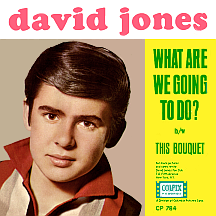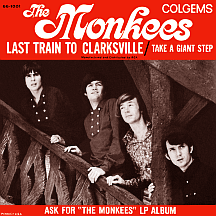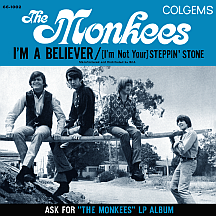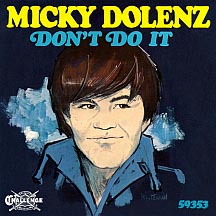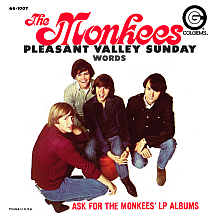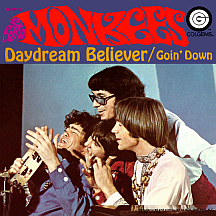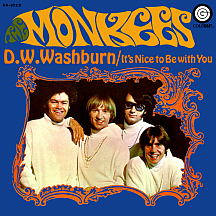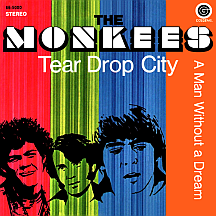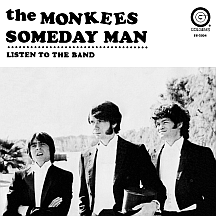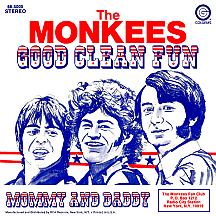THE MONKEES
They were four show business hopefuls unacquainted with one another. Each grew up in different surroundings: Washington, D.C., Houston, Los Angeles and Manchester. Whether it was sheer luck or a keen eye for talented actors, comedians, musicians ersatz or genuine, each of whom would complement the other, Bob Rafelson and Bert Schneider made outstanding choices when they assembled the cast of NBC's The Monkees. Ultimately, the four are more fondly remembered for their music...though the show was pretty memorable too.
It didn't come off exactly as originally outlined, but then things of lasting beauty seldom do; as of the spring of 1965 the plan was to do a half hour comedy show about The Lovin' Spoonful, a real but presumably struggling rock and roll band. Negotiations stalled and within a few months the group was in the top ten with "Do You Believe in Magic" and thus no longer struggling. Raybert Productions (Bob and Bert's new production company formed specifically for the show) had to find a new group to build the show around...so they decided to create one from scratch.
Though Rafelson claimed he'd come up with the concept two or three years earlier, it was the rapid emergence of The Beatles in 1964 (in particular their hit movie A Hard Day's Night) that made it easier to convince Screen Gems to approve the making of a pilot episode (the jump-on-the-bandwagon studio heads liked the idea of a show about an "American Fab Four"). In September '65 ads were run in Variety and the Hollywood Reporter seeking "folk and roll musicians" who also happened to be "insane boys" for an unspecified project. More than four hundred applicants replied, though one future cast member, a teenager from England, was right under the producers' noses. By October 1965 the cast had been hired. Tommy Boyce (with one minor hit as a singer, "I'll Remember Carol," on his resumé) and songwriting partner Bobby Hart (the fifth and sixth Monkees, you could say) were brought in to write music for the pilot. It was set to be filmed within a few short weeks.
Peter Thorkelson's main interest was folk music, but he could adapt to just about anything since he played guitar, bass, piano, banjo and a few other instruments. Born in the District of Columbia in 1942, he settled into New York's Greenwich Village folk scene in '63, playing with several groups over the next couple of years. By mid-1965 he was in L.A., practicing with Stephen Stills and Ron Long in the oddly-named Buffalo Fish while working as a dishwasher to keep a few bucks in his pocket. Stills answered the "insane boys" ad but was rejected, so he urged Peter to give it a try. He got the gig, shortened his name to Peter Tork, and proceeded to hang around the other three hirees with hopes high. Within months Stills was in another band which, coincidentally, also had "Buffalo" as part of its name.
Mike Nesmith was several months younger than Tork, a Houston native whose mother, office typist Bette Nesmith, invented Liquid Paper correction fluid and eventually became a multi-millionaire. He was in the Air Force from 1960 to 1962 before embarking on his own folk music career, starting with a single, "Wanderin'," on the obscure Highness label. Other projects followed, including a 1965 folk-rock single recorded with John London, "How Can You Kiss Me" on Omnibus Records, credited to Mike and John and Bill. The lyrics of "The New Recruit" confronted the dilemma of a young man forced to kill others during wartime; the message song came out on Colpix in 1965 under the name Michael Blessing and there was one follow-up, but he was not the first future Monkee to have a solo record released on the Colpix label.
Micky Dolenz was an L.A. boy who, at age eleven, starred in his own television series, Circus Boy (a Screen Gems production, as it turns out). Set at the turn of the century, it also starred Noah Beery, Jr., Robert Lowery (the Caped Crusader of the 1949 movie serial Batman and Robin, our first Batman-Monkees connection) and the lovable Bimbo the Elephant, the young star's closest acting partner. The show ran Sunday nights on NBC during the 1956-1957 season and moved to ABC's Thursday night lineup from '57 to '58. He used the name Mickey Braddock in those days and even did a little singing on the show. With his entrance into pop music stardom a decade later he beat the odds that have always seemed to plague child actors. Micky played guitar during his teens and joined a band called The Missing Links; a few songs were recorded, but nothing came of this first attempt to make a mark in the music business.
David Jones, on the other hand, had some lucky show biz breaks during his teens. The Manchester, England lad started his career doing BBC radio dramas, made an appearance on the top-rated TV series Coronation Street in 1961, then decided his five-foot-three frame would suit him well as a racehorse jockey. Before he could take that idea very far, he won the role of the Artful Dodger in the London stage production of Lionel Bart's Oliver! (based on the works of Charles Dickens), which later landed him on Broadway and resulted in a 1963 Tony Award nomination for Best Featured Actor in a Musical. As a bonus, cast members were booked to perform a scene from the stage show on the February 9, 1964 Ed Sullivan Show, the same night as the American TV debut of The Beatles, a coincidence that, after witnessing the throngs of screaming, fainting girls, made David seriously consider a career as a rock musician.
After another Dickensian stage play, Pickwick, he signed with the Colpix label. The captivating "What Are We Going To Do?" made a brief chart appearance in August 1965. By the time he'd released three singles and one album (predating Michael Blessing's record by only a few weeks), David was already being considered for The Monkees. Thanks in part to exposure on Shindig and Where the Action Is and his preexisting contract with Colpix (which was owned by Columbia Pictures, parent company of Screen Gems), there was no need for him to answer the ad. Two TV episodes he'd filmed earlier were aired after the Monkees had completed the show's pilot in October '65. The first was a December installment of Ben Casey starring Vince Edwards (wielding a switchblade against the doc himself!) that also featured future Batgirl Yvonne Craig (and there it is, another Batman-Monkees connection). An episode of Inger Stevens' sitcom The Farmer's Daughter in January 1966 served as a prequel to what was coming: Jones took part in the formation of a teenage rock band called Moe Hill and the Mountains, performing a somewhat serious version of Boyce and Hart's "Gonna Buy Me a Dog"...a song that had been released on Colpix a few months earlier by the mysterious Gamma Goochee Himself. The Monkees did a not-so-serious novelty version for their forthcoming album.
Peter, Micky, Mike (or "Wool Hat," as they called him early on) and David (or the less formal "Davy," which seemed a better fit considering his enormous appeal to young female fans) were hardly ready for the coming firestorm. Boyce and Hart composed "(Theme from) The Monkees," a fun little ditty about four guys who 'monkey around,' while helping Rafelson and Schneider make decisions on the role each actor would take based in part on their personalities. The Monkees themselves were given little or no input; after all, they were "fictional" characters! The producers were running the show and wanted Boyce and Hart to take care of the music end of the operation. At one point they considered having Tommy and Bobby do all the singing; the four actors would simply lip-sync the songs. But once it was clear the guys had musical talent (keeping in mind three of the four had already made recordings), it was decided they would supply their own vocals.
Time crunch! Based on the pilot, NBC scheduled the series for a fall 1966 debut. Don Kirshner was hired to get them on the fast track. He reached out to some of the industry's best-known songwriters and came up with a few dozen songs for the guys to record. Nesmith made it known he wanted to write and record some of his own material; they allowed him to produce a session or two with the other three, but didn't commit right away to whether anything would be used. Due to time constraints and the fact none of the Monkees had played together, studio musicians were used on all recordings to guarantee a level of quality. Kirshner told everyone this new group was going to outsell the Beatles!
The Colgems record label was created primarily for the group's releases (other artists appeared on the label, country singer Hoyt Axton inexplicably the first to sign on). Debut single "Last Train to Clarksville" was given promotional priority in August. The Monkees made its TV premiere Monday, September 12. Peter was 24 years old at the time. Mike was 23. Micky, 21. Davy, 20. The appealing young stars with their slapstick antics and catchy pop songs made an immediate connection. Ratings were strong...but radio airplay and record sales were stronger. Boyce and Hart patterned "Clarksville" after the Beatles' summer hit "Paperback Writer," Gerry Goffin and Carole King supplied the flip side, "Take a Giant Step," and the single was in the top ten by the time the fourth episode aired. The self-titled debut album hit stores. "Last Train to Clarksville" reached number one the first week in November. It was all going just as Rafelson, Schneider, Boyce, Hart and Kirshner had planned.
Jones, Dolenz, Nesmith and Tork, on the other hand, were probably in no position to gripe, but they wanted to create their own music and play on their own records. Guitarist Micky had been positioned as the group's drummer on the show, despite Davy's expertise with the instrument (Micky faked it at first and eventually learned to play). Peter was an excellent guitarist but played bass. It was all for show anyway, since studio musicians were supplying all the tracks, some of them recorded in New York and sent to Los Angeles for the group to add vocals; the media picked up on this detail quickly and began calling them the "Pre-Fab Four," an unfair dig at their abilities but an understandable one. Many established songwriters made contributions to the Monkees, including Neil Sedaka, Carole Bayer, David Gates, Harry Nilsson, Toni Stern and the team of Sandy Linzer and Denny Randell. Boyce and Hart were in the best position of all, though Kirshner had the final say on what would be released.
As with the Beatles and Rolling Stones before them (but few other artists), album cuts began getting airplay, most notably Davy's B&H ballad "I Wanna Be Free." That first album spent three straight months at number one (longer than the Beatles had reigned with their first chart-topping LP, giving weight to Kirshner's wild prediction). Neil Diamond (fresh off his first two hits, "Solitary Man" and "Cherry, Cherry") contributed the second single's A side, "I'm a Believer" (with a lead vocal by Micky), number one from late December '66 through mid-February '67, a multi-million seller and one of the biggest hits of the entire decade. Flip "(I'm Not Your) Steppin' Stone" (an answer to Nancy Sinatra's "These Boots Are Made For Walkin'"?) was the closest they came to a garage band sound (another Boyce-Hart creation, it had been recorded earlier by Paul Revere and the Raiders) and became a top 20 hit in its own right.
The group practiced during every spare moment (often skipping sleep) in preparation for a December tour, under pressure to prove their musicianship; soon they were displaying indications that the "Pre-Fab" tag was perhaps premature, though not everyone was convinced. Colgems brass didn't waste any time in getting a second album on the market, only they did it without the group's knowledge, input or approval (not that those things were required under contract or anything). The album came out in January while the band was on the road, the songs chosen by Kirshner from the tracks that had been cranked out for the TV series. The group cried "Foul!" as they had been told they would have creative freedom on the album, as if that was really going to happen. More of the Monkees is actually a terrific collection of songs; it knocked the first album off number one and stayed there over four months, giving them an uninterrupted November-through-June domination of the album charts that, you guessed it, even the Beatles never achieved. More was the number one album of 1967 (I've probably shattered the illusion some hold that it was Sgt. Pepper's Lonely Hearts Club Band, but alas, 'tis not the case).
Challenge Records attempted to cash in with a single release of a Missing Links track, "Don't Do It," credited to Micky Dolenz; the record spent several weeks on the charts in March and April. Diamond's "A Little Bit Me, a Little Bit You" (Davy vocal), the Monkees' third 45, peaked at number two in April (it fell short of the summit thanks to the aforementioned Nancy and dad Frank's "Somethin' Stupid"). Kirshner was fired over a conflict as to what the B side would be (the stakes being big royalty checks, of course): Jeff Barry's "She Hangs Out" with a lead vocal by Davy (featured on the show but left unreleased in the U.S. for several months) or the winner, "The Girl I Knew Somewhere" (Micky vocal), written by Nesmith, a victory in that it was the first original composition by a Monkee to get a single release.
Meanwhile, radio programmers and listeners couldn't get enough; several tracks from More of the Monkees, including Boyce and Hart's Micky-led "She," took coveted airplay slots away from potentially worthy contenders. Even the enchantingly grotesque Jack Keller-Diane Hilderbrand concoction "Your Auntie Grizelda," Peter's first lead on a song, had its share of radio exposure. Los Angeles programmers went to further lengths, taping an unreleased song off the TV show (or maybe a copy of the master tape was slipped to them on the QT?); "Valleri" (spelled "Valerie" at the time since no one had seen the title in print) received so much airplay in the spring of '67 that you'd think it was a number one hit. Frustrated Monkeemaniacs wanted to buy the single but came up empty-handed.
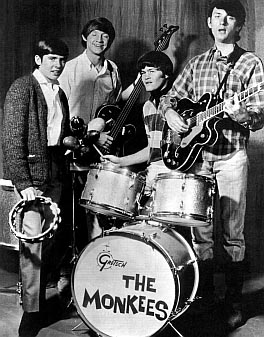
With Don Kirshner gone, the third album, Headquarters, was the Monkees' wish come true; the creative freedom they'd desired was realized during the sessions for what became their third chart-topping LP (and they played their own instruments on most recordings from this point forward). Chip Douglas, a former member of The Turtles, produced this rougher-edged collection of offbeat songs that so thoroughly contrasted the vibe of the first two albums and still came up a success. The socially conscious "Shades of Gray" (penned by Barry Mann and Cynthia Weil) was briefly considered for single release but instead became the album's top track at radio, fitting in reasonably well among the psychedelic sounds that dominated the "Summer of Love." One song from Headquarters did become a single in England: "Randy Scouse Git," a bewildering train-of-thought exercise by Dolenz with a fabulously catchy melody written during the group's visit to the U.K. earlier in the year, came out as "Alternate Title" (it seems the actual title, which isn't a part of the lyrics, is Brit slang for "dirty old man," or something to that effect, so it was decided not to risk offending the public, the BBC, the Queen, or whoever). The record went to number two in July but received a lot less exposure in the States.
Goffin and King contributed a message song of their own, "Pleasant Valley Sunday." A jab at suburban living, it was the A side of the group's fourth single and a big summer hit. The flip, Boyce and Hart's well-crafted "Words," was almost as big. John Stewart of The Kingston Trio penned the next single, "Daydream Believer," an instant smash ('What number is this, Jim?...7-A!!!') that shot to number one in December simultaneous with Pisces, Aquarius, Capricorn and Jones, Ltd. (featuring the first appearance on album of "PVS," "Words" and an alternate version of "She Hangs Out"). B side "Goin' Down" (writer credits going to Hilderbrand, Tork, Nesmith, Dolenz and Jones) came to life while the tape was rolling on an impromptu jam session.
The four had become very comfortable as a group but began to drift away at this time, taking on individual projects little more than a year after their debut, while still filming the second (and last) season of the series. Mike scored his first outside hit as a songwriter, "Different Drum" by Stone Poneys (helping lead singer Linda Ronstadt kick off more than two decades of soon-to-be solo success), though he had written the song prior to becoming a Monkee. Peter hooked up with George Harrison in early '68 for the Beatles guitarist's first solo project Wonderwall Music, laying down some banjo tracks at the sessions. Micky and Davy remained focused on the Monkees and would be the last men standing when the group whittled itself down to two.
"Valleri" had been so widely accepted in the spring of 1967 that a new recording was made adding horn overdubs and expanding the original's spanish-style guitar solo; the track was released as a single and hit the top ten in the spring of '68, just after filming of the TV series had wrapped (it remained on the air through August). Its flip side, "Tapioca Tundra," was a strange combination of various poems written by Nesmith and formed into an infectiously unique slice of madness that reached the top 40. The group's four-way split personality was cleary evident by this time; a Coasters tune written by Jerry Leiber and Mike Stoller, "D.W. Washburn," came next, the first of many singles to fall short of the top ten.
When the TV series ended, they began working on a feature film, Head, written by B movie actor Jack Nicholson (still a couple of years away from superstardom). A disastrous mess (albeit with random moments of brilliance) quite unlike the small screen series, the film flopped upon its November '68 release yet became a cult favorite in later years, though I suspect that's mainly because it's a Monkees movie. Nicholson was given creative freedom in editing the psychedelic soundtrack album, which featured at least one awesome track, "Porpoise Song." But those huge hit singles were already a thing of the past. Album sales had also fallen off the edge of our flat, square planet. The audience that accepted the 90-degree shift of Headquarters rejected the 180-degree turn into a Head hard to fathom. In December an NBC special, 33 1/3 Revolutions Per Monkee, was filmed with guest appearances by Jerry Lee Lewis, Fats Domino and Little Richard, along with gospel music's Clara Ward Singers, the somewhat scary Brian Auger and the Trinity with Julie Driscoll and up-and-coming rockers The Buddy Miles Express...a wild mix worth watching, if for no other reason, as a bizarre time capsule artifact of the late 1960s.
Peter Tork quit the group after the TV special was taped (he was long gone by the time it aired in April '69 against ABC's broadcast of the Academy Awards, ensuring few would see it). Nesmith considered leaving as well, but figured there were still things he wanted to express through the group's music. The three, however, continued to work separately much of the time. Another B&H tune, "Tear Drop City," was a nice throwback to the '66 sound. "Someday Man," written by Paul Williams and Roger Nichols, had potential as well. Nesmith's "Listen to the Band" (introduced on the TV special, it blended a country rock base with an R&B horn section) seemed promising. "Good Clean Fun," another Nesmith effort, fiddled its way further into country territory. Dolenz's "Mommy and Daddy" made statements about drugs, violence and other sensitive issues. All had potential to become hits, but none made the grade. The three went on tour with an R&B band, Sam and the Goodtimers, providing a heretofore unthought-of added dimension. Erratic on-camera behavior during guest appearances on The Glen Campbell Goodtime Hour and Johnny Carson's Tonight Show made it painfully obvious the end was near.
Mike Nesmith walked away and formed The First National Band, scoring with the hit "Joanne" and two follow-ups in '70 and '71. Micky Dolenz and Davy Jones continued as the Monkees, most likely for the purpose of satisfying contractual agreements. A music video (the first non-TV-related clip) was shot for the Jeff Barry-Andy Kim tune "Oh My My," but the single only scraped the bottom of the national chart in June '70. They'd split by year's end, but the four individual members of The Monkees didn't so easily forfeit the phenomenon that had made them stars. There were solo projects (Davy hit the charts with "Rainy Jane" in '71). Revivals with various group members occurred every few years (Boyce and Hart even recorded and toured with Dolenz and Jones in the mid-'70s). Nesmith was the most elusive, but occasionally joined in the fun. An MTV-fueled revival (with Micky, Davy and Peter) put the group back on the map and into the top 20 (with "That Was Then, This is Now") in the mid-'80s. The band's legend has grown in the years since with several more reunions and one unexpected tragedy. I'm a big fan of The Monkees and their music. I suspect there are millions more (tens of millions, maybe hundreds of millions?) who feel the same way.
NOTABLE SINGLES:
- Wanderin' - 1963
by Mike Nesmith - Dream Girl - 1965
by David Jones - How Can You Kiss Me - 1965
by Mike and John and Bill - What Are We Going to Do? - 1965
by David Jones - The New Recruit - 1965
by Michael Blessing - Last Train to Clarksville /
Take a Giant Step - 1966 - I'm a Believer /
(I'm Not Your) Steppin' Stone - 1967 - Don't Do It - 1967
by Micky Dolenz - A Little Bit Me, a Little Bit You /
The Girl I Knew Somewhere - 1967 - Alternate Title - 1967
- Pleasant Valley Sunday /
Words - 1967 - Daydream Believer /
Goin' Down - 1967 - Valleri /
Tapioca Tundra - 1968 - D.W. Washburn /
It's Nice to Be With You - 1968 - Porpoise Song /
As We Go Along - 1968 - Tear Drop City - 1969
- Someday Man /
Listen to the Band - 1969 - Good Clean Fun /
Mommy and Daddy - 1969 - Oh My My - 1970
- Joanne - 1970
by Michael Nesmith and the First National Band - Silver Moon - 1970
by Michael Nesmith and the First National Band - Nevada Fighter - 1971
by Michael Nesmith and the First National Band - Rainy Jane - 1971
by Davy Jones - I Really Love You - 1971
by Davy Jones - Christmas is My Time of Year - 1976
as Dolenz, Jones and Tork - That Was Then, This is Now - 1986
- Heart and Soul - 1987


